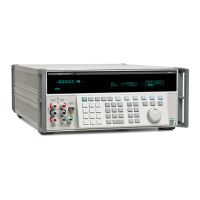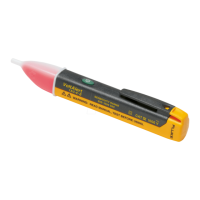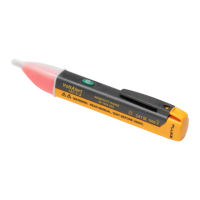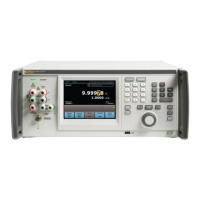Do you have a question about the Fluke 5700A Series II and is the answer not in the manual?
Overview of the Fluke Model 5700A/5720A Series II Calibrators and their capabilities.
Guide to locating specific information within the manual.
Details on support equipment and services offered by Fluke for the calibrator.
Procedure for calibrating the calibrator in place using Fluke design breakthroughs.
Presents verified and calibrated specifications to maintain high performance.
Details on operating temperature, interfaces, power, size, and weight.
Provides absolute and relative uncertainty specifications for DC voltage.
Details AC voltage specifications including absolute and relative uncertainty.
Presents resistance specifications including absolute and relative uncertainty.
Provides DC current specifications with absolute and relative uncertainty.
Details AC current specifications including absolute and relative uncertainty.
Provides instructions for unpacking and installing the calibrator.
Instructions for inspecting the calibrator for damage during shipping.
Guidelines to maintain internal temperature for optimal performance and longevity.
Procedure for accessing and replacing the line power fuse.
Instructions for setting the operating line voltage and power cord types.
Reference for calibrator features and locations.
Details on controls, displays, indicators, and terminals on the front panel.
Information on the screen saver function that blanks the display after inactivity.
Description of terminals, sockets, and connectors on the rear panel.
Instructions for operating the calibrator from the front panel.
Procedure for powering on the calibrator and its self-test sequence.
Specifies the necessary warm-up time for component stabilization.
Explains the automatic process to remove offset and gain errors.
Guidance on connecting the calibrator to the Unit Under Test.
Criteria for using external sensing to minimize cable voltage drop errors.
Guidance on using the voltage guard for electrical shielding and noise reduction.
Explanation of when and how to use the current guard for leakage path reduction.
Procedure for setting output function and amplitude.
Step-by-step guide to setting a DC voltage output.
Step-by-step guide to setting an AC voltage output, including dBm.
Instructions for setting a DC current output.
Instructions for setting an AC current output.
Procedure for selecting and setting resistance outputs.
Explanation of UUT errors: offset, scale, and linearity.
Procedure to set entry limits for voltage and current to prevent damage.
Overview of operating the calibrator remotely.
Instructions for connecting and configuring the IEEE-488 interface.
Instructions for connecting and configuring the RS-232C serial interface.
Rules for remote command syntax, parameters, and expressions.
Summary and protocol details of remote commands.
Explanation of status registers and how to check calibrator conditions.
Information on the fault queue for storing and reading fault codes.
Explanation of device-dependent commands, common commands, and interface messages.
Methods to control command execution order and detect operation completion.
Details on emulating 5100B or 5200A calibrators for command compatibility.
Describes transitions between local, remote, and lockout operating states.
Details local-to-remote transitions during 5200A emulation.
Describes RS-232C setup for remote control and data transfer.
Details RS-232C connector pinout and interface parameter choices.
Step-by-step guide to configuring the serial interface for application use.
Information on generating calibration check and calibration reports.
Description of the calibration shift results printout content.
Details on the printout for calibration check shift results.
Procedure for generating calibration shift result printouts.
Explains routine maintenance and calibration tasks for optimal operation.
Procedure for accessing the fuse holder on the rear panel.
Instructions for removing and cleaning the air filter to prevent overheating.
Overview of calibration procedures to external standards and checks.
Procedure for calibrating to external standards at the beginning of the calibration cycle.
Step-by-step guide for calibrating the main output functions.
Procedure for adjusting range constants to align with laboratory standards.
Procedure for performing the wideband gain calibration.
Procedure to confirm calibrator integrity without external standards.
Description of options and accessories to enhance calibrator capabilities.
Details on the Wideband AC Voltage Module for calibrating RF voltmeters.
Summary of available accessories for the 5700A/5720A Series II Calibrator.
Description of available low thermal test leads designed to exhibit low thermal emfs.
Information on the Fluke 732B as a portable voltage reference standard.
Details on 742A Series Standard Resistors for calibration support.
Information on the 5725A Amplifier for extending high voltage and current performance.
List of fault codes categorized by subsystem.
Reference for ASCII and IEEE bus codes.
Table of symbolic names and descriptions for calibration constants.
Definitions of terms used throughout the manual.
Overview of the Fluke Model 5700A/5720A Series II Calibrators and their capabilities.
Guide to locating specific information within the manual.
Details on support equipment and services offered by Fluke for the calibrator.
Procedure for calibrating the calibrator in place using Fluke design breakthroughs.
Presents verified and calibrated specifications to maintain high performance.
Details on operating temperature, interfaces, power, size, and weight.
Provides absolute and relative uncertainty specifications for DC voltage.
Details AC voltage specifications including absolute and relative uncertainty.
Presents resistance specifications including absolute and relative uncertainty.
Provides DC current specifications with absolute and relative uncertainty.
Details AC current specifications including absolute and relative uncertainty.
Provides instructions for unpacking and installing the calibrator.
Instructions for inspecting the calibrator for damage during shipping.
Guidelines to maintain internal temperature for optimal performance and longevity.
Procedure for accessing and replacing the line power fuse.
Instructions for setting the operating line voltage and power cord types.
Reference for calibrator features and locations.
Details on controls, displays, indicators, and terminals on the front panel.
Information on the screen saver function that blanks the display after inactivity.
Description of terminals, sockets, and connectors on the rear panel.
Instructions for operating the calibrator from the front panel.
Procedure for powering on the calibrator and its self-test sequence.
Specifies the necessary warm-up time for component stabilization.
Explains the automatic process to remove offset and gain errors.
Guidance on connecting the calibrator to the Unit Under Test.
Criteria for using external sensing to minimize cable voltage drop errors.
Guidance on using the voltage guard for electrical shielding and noise reduction.
Explanation of when and how to use the current guard for leakage path reduction.
Procedure for setting output function and amplitude.
Step-by-step guide to setting a DC voltage output.
Step-by-step guide to setting an AC voltage output, including dBm.
Instructions for setting a DC current output.
Instructions for setting an AC current output.
Procedure for selecting and setting resistance outputs.
Explanation of UUT errors: offset, scale, and linearity.
Procedure to set entry limits for voltage and current to prevent damage.
Overview of operating the calibrator remotely.
Instructions for connecting and configuring the IEEE-488 interface.
Instructions for connecting and configuring the RS-232C serial interface.
Rules for remote command syntax, parameters, and expressions.
Summary and protocol details of remote commands.
Explanation of status registers and how to check calibrator conditions.
Information on the fault queue for storing and reading fault codes.
Explanation of device-dependent commands, common commands, and interface messages.
Methods to control command execution order and detect operation completion.
Details on emulating 5100B or 5200A calibrators for command compatibility.
Describes transitions between local, remote, and lockout operating states.
Details local-to-remote transitions during 5200A emulation.
Describes RS-232C setup for remote control and data transfer.
Details RS-232C connector pinout and interface parameter choices.
Step-by-step guide to configuring the serial interface for application use.
Information on generating calibration check and calibration reports.
Description of the calibration shift results printout content.
Details on the printout for calibration check shift results.
Procedure for generating calibration shift result printouts.
Explains routine maintenance and calibration tasks for optimal operation.
Procedure for accessing the fuse holder on the rear panel.
Instructions for removing and cleaning the air filter to prevent overheating.
Overview of calibration procedures to external standards and checks.
Procedure for calibrating to external standards at the beginning of the calibration cycle.
Step-by-step guide for calibrating the main output functions.
Procedure for adjusting range constants to align with laboratory standards.
Procedure for performing the wideband gain calibration.
Procedure to confirm calibrator integrity without external standards.
Description of options and accessories to enhance calibrator capabilities.
Details on the Wideband AC Voltage Module for calibrating RF voltmeters.
Summary of available accessories for the 5700A/5720A Series II Calibrator.
Description of available low thermal test leads designed to exhibit low thermal emfs.
Information on the Fluke 732B as a portable voltage reference standard.
Details on 742A Series Standard Resistors for calibration support.
Information on the 5725A Amplifier for extending high voltage and current performance.
List of fault codes categorized by subsystem.
Reference for ASCII and IEEE bus codes.
Table of symbolic names and descriptions for calibration constants.
Definitions of terms used throughout the manual.
| Type | Multifunction Calibrator |
|---|---|
| Operating Temperature | 0 °C to 50 °C |
| Storage Temperature | -20 °C to 70 °C |
| Voltage Range | 0 to 1100 V |
| DC Voltage Range | 10 μV to 1100 V |
| Frequency Range | 1 MHz |
| Humidity | non-condensing |
| Power Requirements | 100 V to 240 V |











